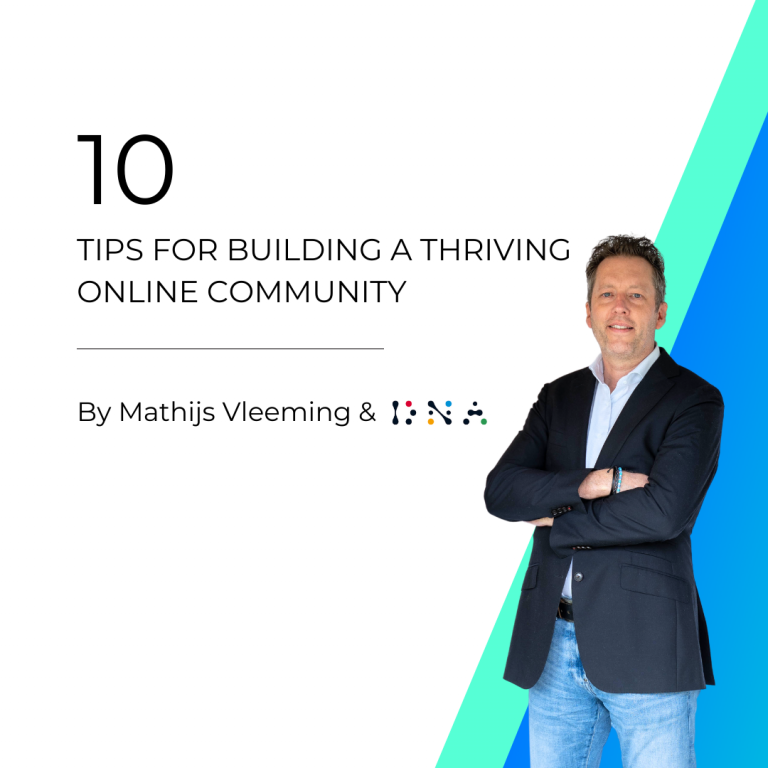How do you help your virtual community to grow?
How you expand your community depends on what type of organisation you have and exactly who your target audience is. Can anyone participate in the community or is it only for members of your organisation? Are you focused on recruiting new members or not?
Community growth requires long-term commitment
A thriving online community is the dream of many a community manager. But building an engaged, active community is easier said than done. Because it is about relationships between people, it often takes patience.
Nevertheless, there are things that contribute to successfully setting up a new community or expanding an existing one. We have listed them below.

What forms of community growth are there?
If you want to grow an online community, it is a good idea to not only think about the how, but especially the why. After all, a larger community is not necessarily more active or engaged. In essence, there are three types of growth we see a lot in online communities:
1. Organic or natural growth
We speak of organic growth when an online community grows larger, without being instigated by, say, a community manager. Members nominate new community members and a network of people with a common bond emerges and expands organically.
Another example of organic growth is natural recruitment. Within any group of people, someone leaves from time to time. Replenishing those who leave ensures that the group’s membership remains more or less stable. You achieve this by adding new members to the group at a leisurely pace.
2. Growth through expansion
Deliberate, steady growth is called expansion. In the early stages of the community, this expansion ensures that the group reaches a critical mass of activity.
A lively and engaged entity is created, where members feel they are engaged in relevant issues. Growth via expansion has to be deployed at times so that the group remains interesting and can adapt to a changing ecosystem.
Sometimes, the ambition to expand comes from the group members so that they have a wider reach or generate more attention. Be aware that the number of members grows whilst engagement could actually decrease.
Also read 12 tips to encourage activity in an online community
Examples of expansion
In some organisations, as is the case at KNVB and Nevi, the community grows via the existing membership base. Account managers or other active members ask people to join. That’s how you get new members.
Another possibility is to expand the original target group. For example, the original target audience of KNVB’s community consisted of football administrators. They are now expanding that by also inviting referee coordinators. NVM initially targeted estate agents with their community, but they plan to involve agency staff later.
3. Growth through the existing membership base
An engaged, active community can often do a lot to bring about growth on its own. Word of mouth remains an ideal way to recruit new members. Although a community is not a product, potential members invest their time and energy in a new group of people. And a warm recommendation from someone they know and trust matters.
This type of growth often results in many relevant contacts. The people who get the recommendation already know at least one other member of the group. When the community grows in this way, it also often creates a snowball effect. New members also reintroduce people within their network, which can quickly create a new group that still has a connection.
As a community manager, you can steer this process by opening the conversation about the type of members you would like to attract and by sharing the long-term vision of the community. This will help you keep a grip on the spirit within the group and the quality of the content you want to deliver to existing members. You can also ask existing participants to share interesting public content from the community through their networks.
How can you help your community to grow?
1. Increase usability with an SSO link
Some organisations connect all their members at once via an SSO link. SSO means ‘Single Sign-On’. This is a type of authentication tool that allows users to access multiple applications and services with a single set of login credentials.
Single Sign-On makes life a lot easier because users do not have to remember multiple passwords and do not have to keep resetting forgotten passwords. By increasing the ease of use of an online community, members enjoy coming back.
2. Collaborate with others
Collaborating with other groups that overlap with a particular community can quickly provide a lot of, high-quality growth. Often, it does not make much sense to connect widely diverse communities. It makes more sense to connect groups that are an extension of each other and can learn from one another as a result.
TVVL’s community grows, for example, by collaborating with other member organisations. By having several organisations participate on your platform, your reach increases.
3. Share user-generated content
Making some of your user-generated content public can be a great move. By posting some of your content before the log-in, you show potential new members what your community has to offer.
When community members generate content that is relevant to the community and non-members, trust in a group can grow dramatically. After all, members do not get paid for their posts or other remarks on social media. They are disinterested parties and honest; so, people know exactly what to expect.
This kind of content also feels personal and genuine. If you see posts from members of a community that you like, chances are you will want to be part of such a group. The more connected people feel with group members, the more likely they will be attracted to the community. By showing who is part of the community and how they think about issues, you will automatically attract members who match.
Thanks to existing community platforms, we have seen that Google highly values public content and places it higher in search results. The organic traffic to the community through search engines generates new traffic.
4. Utilise social media
Although you can also distribute user-generated content through social media and the two are an extension of each other, they are not the same thing. Many people use social media these days and, as a community manager, you can leverage these kinds of channels for growth on your own platform.
For example, share community highlights on social media. Post other content that gives potential new members insight into what is going on within the community. Or place a recruiting ad on the social media channels where your potential members are. It is then easy to refer new members to your own platform.
5. Promote growth in existing communication channels
You can promote your community by including it in your existing communication channels. Share information and content through the channels you already have. For example, post it on existing websites, or in your newsletter.
Just keep in mind that the reach of your existing communication channels reaches its maximum at some point. Do you really want to reach relevant new members outside the existing networks? Then choose, for example, to actively harvest new e-mail addresses on your website, so that you can regularly add new e-mail addresses to your mailing list.
Relevance, vibrancy and activity
Whatever growth strategy you choose, growing a community will always be a tough job if there is no relevant content, or if the group is idle. So to conclude, we would like to give you some tips to keep the group relevant and active.
- Stability over quantity. A good starting point for a start-up online community is to post a relevant post about twice a week. Preferably not on one day, but always with several days in between. Of course, you can prepare these kinds of posts in advance, and then publish them eight times a month.
- For communities just starting out, you can plan one welcome message and four messages in which you seek exchanges with members, such as polls, questions or a relevant statement.
- Start with a few high-profile members. If you know people who know a lot about the subject, you can approach them personally and invite them to be part of a start-up community. This way, new members will immediately see that the content has quality.
- Posts from individuals often score better than posts from pages. So explore the possibility of allowing individuals to share posts so that these posts stand out more.
- If you assign a category to posts, older posts will remain visible and members can more easily find valuable information.
Need help setting up your online community?
Our team is ready to assist you in providing your members with an attractive online community. Our community software offers many components to help you. Our team will be happy to assist you every step of the way personally. Feel free to contact us.
Also read

Sharing knowledge and the changing role of associations [2/5]

10 tips for building a thriving online community

